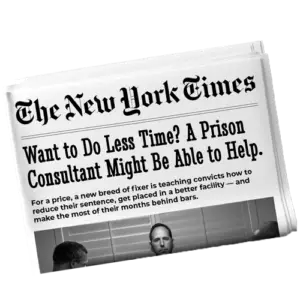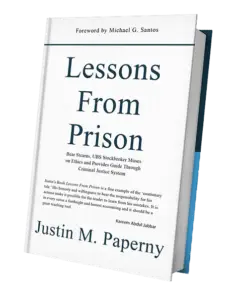An executive in the Midwest indicted for mail fraud—texted me:
“How do you get out of federal prison early?”
I told him I’d write this blog. And I told him to do two things:
- Join our webinar Monday.
- Watch the replay of “Back to the Basics,” a webinar we just hosted that covers this exact topic.
This isn’t something you want to research after you surrender. The earlier you understand these options, the better your chances of qualifying for one or more of them. None are guaranteed. But each is possible—if you’re willing to do the work and prepare properly.
Here are the four options that matter if your goal is to leave federal prison early:
- Good Time Credit
- RDAP
- First Step Act/ Compassionate Release
- Executive Clemency
1. Good Time Credit: Earn It, Track It, Protect It
Most people in federal prison serving a sentence longer than one year qualify for Good Time Credit. Under 18 U.S.C. § 3624(b), you can earn up to 54 days off per year of your sentence. That’s nearly seven weeks per year shaved off if you follow the rules.
Sounds simple. But a lot of people lose those days without even realizing it.
To earn Good Time Credit:
- Your sentence must be at least 12 months and 1 day.
- You must avoid disciplinary infractions.
- You must have a high school diploma, GED, or be actively working toward one.
That last point trips up more people than it should. If your PSR doesn’t show proof of your diploma or GED, you’ll need to enroll in the education program. And if you violate even rules, your time can be reduced or eliminated.
Here’s an example:
Someone in our community lost 30 days because he made a three way phone call from the prison–he called his son, who conferenced in another family member.
He didn’t break the law. He didn’t cause problems. But he made a preventable mistake, and it cost him a month of good time credit. If you want to leave federal prison early, you have to understand the rules, both written and unwritten.
So yes, earn the credit—but just as importantly, protect it. Update your paperwork, stay in communication with your unit team, and don’t assume anything.
2. RDAP: Take One Year Off of Your Sentence
RDAP—the Residential Drug Abuse Program—is one of the only ways to take a full year off your sentence, along with potential early halfway house placement.
But there’s one rule:
If your PSR doesn’t reflect a documented substance abuse issue before sentencing, you will not qualify.
And no, you can’t fix it after you surrender. You can’t walk into the prison and say, “I drank a lot during my case.” That’s not how it works.
The BOP assumes you’re saying it just to get a year off. They’ve heard it before. That’s why your documentation has to be in the official record—your Presentence Investigation Report.
Glenn Hudson is a great example. Glenn served time at FPC Texarkana and completed RDAP successfully. He did it the right way: before sentencing, he worked with a licensed therapist who completed a formal assessment and report. That documentation was included in his PSR.
Glenn told us in a video:
“Only 16 out of 33 people completed RDAP at Texarkana.”
That’s less than half. Why? Because many show up unprepared. They say what they think staff wants to hear but have no documentation. RDAP staff are skeptical. They know the stakes. They assume you’re gaming the system unless you prove otherwise.
Your goal isn’t just to say you need RDAP—it’s to show it in a way that satisfies the BOP’s standards. That starts with a professional evaluation, before sentencing, from someone who understands what documentation the BOP expects.
Start early. Prepare your PSR. Don’t lose a year over silence.
You can read the RDAP Program Statement here:
📎 RDAP Policy Document – Program Statement 5330.11
3. Compassionate Release: Real, But Not Automatic
Since the First Step Act passed, people in federal prison have a path to request compassionate release without relying on the Bureau of Prisons to recommend it.
That’s a huge shift. You can now go directly to the sentencing judge—after first filing a request with the warden and waiting 30 days.
But that doesn’t mean your odds are high. Judges are flooded with motions that boil down to, “I’ve served enough time” or “I’ve changed.” That’s not enough.
To qualify, you need to show how you are like Tracii Hutsona:
- A significant change since sentencing (e.g., terminal illness, death of a caregiver)
- A sustained record of rehabilitation
- A specific reentry plan: housing, work, insurance, family support
We worked with a client who received compassionate release nearly two years early. His wife’s health deteriorated rapidly. In prison, he’d documented his progress: coursework, service projects, written reflections, and family support. His plan for release was organized, realistic, and detailed.
That’s what persuaded the judge. Not just the change in circumstances—but the work that had been done leading up to the request.
Compassionate release is possible. But you must:
- Show why your situation is extraordinary
- Prove how you’ve changed
- Provide a plan that removes risk
This takes time. Build the record while you serve. Not after.
4. Executive Clemency: Not a Long Shot If You’ve Built Something
Executive Clemency—commutations and pardons—comes from one person: the President of the United States. And yes, it’s rare.
But we’ve seen it happen.
Jerry Lundergan received a presidential pardon from President Biden. The justification from the DOJ specifically cited his volunteer work with our nonprofit. While incarcerated, Jerry helped grow a program that now reaches millions of incarcerated individuals annually.
He didn’t wait for release to get involved. He started helping others inside. He documented it. He led projects. He contributed to something bigger than himself.
That’s what got noticed.
If you want clemency to be a possibility in the future, you need to start preparing now. That means:
- Building a record of contribution
- Being consistent over time
- Creating documentation that shows your value to others
Clemency isn’t granted because you stayed out of trouble. It’s granted because you’ve gone above and beyond—and you can prove it.
What You Should Do Right Now
If you’re serious about early release, here are four steps to take immediately:
- Review your PSR.
If there’s a history of alcohol or drug use, is it documented clearly and credibly? - Get a licensed substance abuse evaluation.
Don’t wait. If you’re even thinking about RDAP, this is the first requirement. - Start documenting everything.
Classes, service, letters, journal entries, mentor efforts—track it. Keep a running log. Build your file now, not later. - Write your release plan.
Where will you live? Who’s supporting you? What’s your employment plan? Judges and wardens take this seriously. You should too.
What Makes You Different?
Put yourself in the shoes of a judge, a warden, or a case manager. They read the same letters, hear the same excuses, and deal with the same promises all day long.
So ask yourself:
Why should they believe you?
What makes you compelling?
What makes your story different from the next 100 people asking for early release?
Doing the minimum isn’t enough.
If you want to know what “extraordinary” looks like, start by reading about Tracii Hutsona. She didn’t just go to federal prison quietly. She documented her progress in a way that mattered. Her story made people stop and pay attention.
That’s your job now—to build a story that earns attention, earns trust, and earns liberty.
If you want help putting it together, join our next webinar. Or schedule a personal call. There’s work to do—but you don’t have to do it alone.
Justin Paperny



